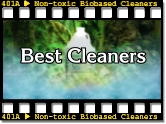
|
|
|
OVERVIEW
OF INDOOR AIR QUALITY ISSUES
Part
3 –
What We Don’t Know
but Should Know
about the Air
We Breathe –
C.
What Do We Need to Know?

|
C. What do we need to know?

Research
into Indoor Air Quality (IAQ) issues can quickly lead to information
overload.
With
hundreds of products on the market and with all sorts of acronyms,
initials, trade specific terms, and trade names with which to become
familiar, how does one know which equipment to acquire or whose
services to engage?
Do we know for certain what issues need addressing?
Do we have to do anything?
If we do something, are we sure that what we are
doing will work with the problems we have?
Are
we approaching the need the best way?
Are
we doing enough to deal with the problems effectively?
Is there, as with drinking water, such a thing as too much good air
or too pure
an air quality?
Cutting
through all of the above can take a lot of time, energy, and expense
when those commodities may not be in abundant supply.
Fortunately,
a brief understanding of the problems and the science behind the
solutions can help us reach a satisfactory understanding and set us on
an active path of correction and prevention.
|
D. What are we breathing?
 It's more than just air. If asked, most
of us could hardly identify more than oxygen as one of the components
of this amazing mixture of gases we were designed to and are allowed to
breathe. Each proper ingredient has a role to play in our ongoing
survival and health. And each of those ingredients is kept in proper
balance by natural processes which follow natural laws so that we do
not normally overload on any one ingredient without the benefit of the
others in the right proportion to one another. It's more than just air. If asked, most
of us could hardly identify more than oxygen as one of the components
of this amazing mixture of gases we were designed to and are allowed to
breathe. Each proper ingredient has a role to play in our ongoing
survival and health. And each of those ingredients is kept in proper
balance by natural processes which follow natural laws so that we do
not normally overload on any one ingredient without the benefit of the
others in the right proportion to one another.
We don't ask. We don't
pay attention. We don't worry about it. We just breathe, and the right
mixture of air comes in our lungs when we inhale. Within seconds or milliseconds, a
phenomenal exchange of gases and wastes takes place internally, and we exhale. Bodily processes make use of the gases we
took in. Forces of nature fix the garbage we breathed out and supply
what we need for the next breath in. It's really pretty
amazing.
Atmospheric
Components

The
air we breathe, and upon which life on earth depends, is about
a 12-mile-thick layer wrapped around our planet called the
"Troposphere". It is where all of our weather (the primary natural air
purification processes) takes place. As the chart below suggests, it consists of
about 78% nitrogen, 21% oxygen, and 1% of a mixture of argon, helium,
carbon dioxide, and other gases. It also harbors a fair amount of water
vapor and an unwarranted amount of pollution. As this mixture is
inhaled into the lungs, about a fifth of the oxygen is retained while
the rest is exhaled along with carbon dioxide and water vapor. Full
article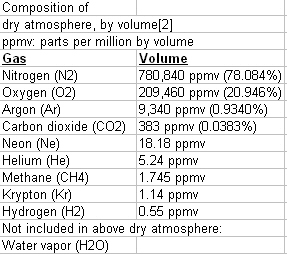
|
The
breathing apparatus
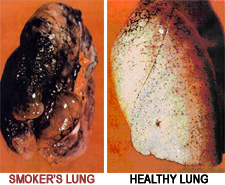
The
inside of the lung resembles a sponge with about 300 million tiny
pockets providing over seventy square yards of surface area for the
exchange of gases in and out of the blood stream. An adult breathes
about 16 times per minute, taking in about one pint of air per breath,
adding up to about 2,000 gallons of air per day. This air travels at
about 50 miles per hour during normal breathing, but
during a sneeze or cough it can reach speeds of 750 miles per hour. The
maximum amount of air a person can inhale and exhale in one breath is
called the "vital capacity". A good vital capacity is related to a
greater life expectancy. Several factors can affect a person's vital
capacity: smoking, air pollution, posture, exercise, obesity, and
shallow breathing. Full
article |
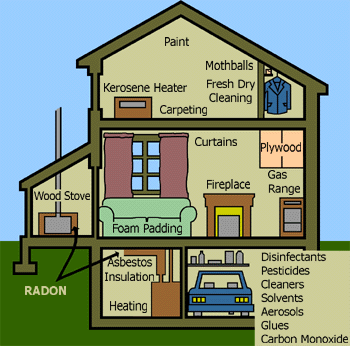 Just as the Earth at large has its atmosphere and air supply, each of
our buildings, regardless of size or purpose, has its own atmosphere
and air supply. Such indoor atmospheres typically represent a
composition similar to the outside air. If the outside air is polluted,
so will the indoor air most likely be polluted. However, because the
volume and circulation of air within a building is limited, even if the
outdoor air is good, the opportunities for polluting the quality of the
indoor air are greatly compounded.
Just as the Earth at large has its atmosphere and air supply, each of
our buildings, regardless of size or purpose, has its own atmosphere
and air supply. Such indoor atmospheres typically represent a
composition similar to the outside air. If the outside air is polluted,
so will the indoor air most likely be polluted. However, because the
volume and circulation of air within a building is limited, even if the
outdoor air is good, the opportunities for polluting the quality of the
indoor air are greatly compounded.
What is also amazing is how resilient our bodies are designed to be to
cope with the consequences when we have managed to mess up that
carefully tuned balance of air components. For awhile, unless the
exposure is extreme or particularly lethal, most of the time we do not
notice the stress we place our bodies under when we expose them
to pollutions and poisons. The body just handles it for a time,
cumulatively getting a little bit weaker, a little bit less capable,
but nothing we might necessarilly recognize as a problem until we
suffer a more severe break down.

It is, perhaps, this resiliency that works so well on our behalf to
help us survive in less than optimal conditions which allows us to
abuse our bodies and the natural systems upon which they rely. And it's
probably our taking it all for granted which causes us so much shock
and consternation when the body just can't adapt any more and starts
breaking down or quitting the fight altogether.
 We have fancy names for
those occurrences -- medical names for maladies, conditions, syndromes,
illnesses, diseases -- so many of which were caused by things with which
we overloaded our bodies. Most of the time, the abuse was unintentional
or ignorant. Sometimes, as with smoking habits and other forms of
chemical pollution, it was deliberate. In either case, our health is
affected and our bodies pay a price. For our own good, we need to
identify what is IN our air supply which does not
belong so that we can take steps, if at all possible, to get it out
before it does US in. We have fancy names for
those occurrences -- medical names for maladies, conditions, syndromes,
illnesses, diseases -- so many of which were caused by things with which
we overloaded our bodies. Most of the time, the abuse was unintentional
or ignorant. Sometimes, as with smoking habits and other forms of
chemical pollution, it was deliberate. In either case, our health is
affected and our bodies pay a price. For our own good, we need to
identify what is IN our air supply which does not
belong so that we can take steps, if at all possible, to get it out
before it does US in.
Below is a list of six general categories, each of which represents a
host of ingredients which do not belong in our breath stream and all of
which pose great dangers to those who breathe them. Click on the first
category, particulates, learn about them, and then follw through each
of the others. Your life and health, and that of your loved
ones, could well depend upon what you are about to discover and what
you do then about it.
|

 

All
materials not supplied by manufacturers or others are
Copyright
2005 - 2014 -- breathe-easier.com -- All Rights Reserved
|
 |
NEW!

Check
out the videos



An introduction to indoor air
quality issues.


B.
What Don't We Know?
--
KWIK FACTS.
The problem is worse than we realize.


C.
What Do We Need to Know?
Sorting out the info and charting
a course to follow.

D.
What are We Breathing?
Unwelcome
guests we receive every time we breathe.
2. Allergens.
The
body’s “hit list” of alien invaders.

3. Pathogens.
The
bacteria, viruses, and germs which reproduce in the human body
and
try to
stage
a
takeover.

4. Odors.
Things
have odors for a reason,
but why?
Can the problem be corrected rather than merely masked or covered up?


5. Chemicals/Smoke/VOC's.
Are we
possibly drowning in a toxic soup?


6. Mold.
Is what we see dangerous?
And is what we don't see
perhaps more dangerous than what we do see?


E.
Which Technology Works the Best?
Are the technologies pretty
much equal, or is their a large disparity among them?


1. Passive Technology.
The pollution finds the solution.
(Or so we hope!)


2.
Active Technology.
The solution finds the pollution -
even where it is hiding!


a. Stage One -- Dual
Ionization (Particulate Removal)


b.
Stage Two -- Quad
Oxidizing Plasmas


c.
Stage Three -- Advanced
Oxidation


d.
Combo Effect -- The
Whole is Greater Than the Sum of its Parts.


3. Major Differences.
Things that are not the same
are not equal.


a. Literally out of this
world.
The technology which produces
"the purest air on the planet"
actually comes from
out of this world.


b. Overall Air Purity.
By what standard do
you certify the actual purity of air?

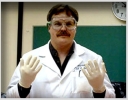
c. Too Clean to Test for Purity?
"Without dirt in the air,
we cannot tell you
how pure the air is."
Does that strike anybody as odd?


d.
Where's the Dirt?
(Where is Clara Peller
when you need her?)


e. What to do?
Anybody
can see that it’s clean except the career bureaucrats.

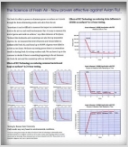
f. Where are the Germs?
Hint: One place they are not
is
"Blowin' in the Wind".


g. Filtration rates vs. Kill
rates.
In the war against pathogens,
would you like your germs
captured and contained
or killed "graveyard dead"?


h.
Odor Abatement/Removal.
The
same thing that RCITM
does to
particulates and germs it does also to smoke, dust, and sources of
odors.


F. What IAQ
issues must be considered and addressed?
Head to head comparison of the technologies - very revealing.


G.
Are there medical considerations?
Obligatory disclaimers and the practical realities of what happens when
a sick body can actually catch its breath.


H.
Are there legal and other considerations?
What happens if we just
ignore the problem or fail to investigate it fully?


I.
When is Timing an Issue?
If
the mold or other air quality problem doesn't seem to be spreading or
getting any worse, so we really have to pay it any attention?
 |










































































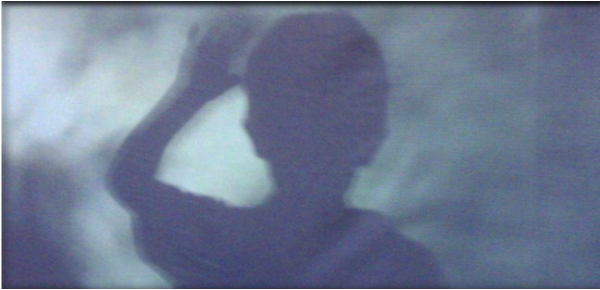
 It's more than just air. If asked, most
of us could hardly identify more than oxygen as one of the components
of this amazing mixture of gases we were designed to and are allowed to
breathe. Each proper ingredient has a role to play in our ongoing
survival and health. And each of those ingredients is kept in proper
balance by natural processes which follow natural laws so that we do
not normally overload on any one ingredient without the benefit of the
others in the right proportion to one another.
It's more than just air. If asked, most
of us could hardly identify more than oxygen as one of the components
of this amazing mixture of gases we were designed to and are allowed to
breathe. Each proper ingredient has a role to play in our ongoing
survival and health. And each of those ingredients is kept in proper
balance by natural processes which follow natural laws so that we do
not normally overload on any one ingredient without the benefit of the
others in the right proportion to one another. 


 Just as the Earth at large has its atmosphere and air supply, each of
our buildings, regardless of size or purpose, has its own atmosphere
and air supply. Such indoor atmospheres typically represent a
composition similar to the outside air. If the outside air is polluted,
so will the indoor air most likely be polluted. However, because the
volume and circulation of air within a building is limited, even if the
outdoor air is good, the opportunities for polluting the quality of the
indoor air are greatly compounded.
Just as the Earth at large has its atmosphere and air supply, each of
our buildings, regardless of size or purpose, has its own atmosphere
and air supply. Such indoor atmospheres typically represent a
composition similar to the outside air. If the outside air is polluted,
so will the indoor air most likely be polluted. However, because the
volume and circulation of air within a building is limited, even if the
outdoor air is good, the opportunities for polluting the quality of the
indoor air are greatly compounded.
 We have fancy names for
those occurrences -- medical names for maladies, conditions, syndromes,
illnesses, diseases -- so many of which were caused by things with which
we overloaded our bodies. Most of the time, the abuse was unintentional
or ignorant. Sometimes, as with smoking habits and other forms of
chemical pollution, it was deliberate. In either case, our health is
affected and our bodies pay a price. For our own good, we need to
identify what is IN our air supply which does not
belong so that we can take steps, if at all possible, to get it out
before it does US in.
We have fancy names for
those occurrences -- medical names for maladies, conditions, syndromes,
illnesses, diseases -- so many of which were caused by things with which
we overloaded our bodies. Most of the time, the abuse was unintentional
or ignorant. Sometimes, as with smoking habits and other forms of
chemical pollution, it was deliberate. In either case, our health is
affected and our bodies pay a price. For our own good, we need to
identify what is IN our air supply which does not
belong so that we can take steps, if at all possible, to get it out
before it does US in.




